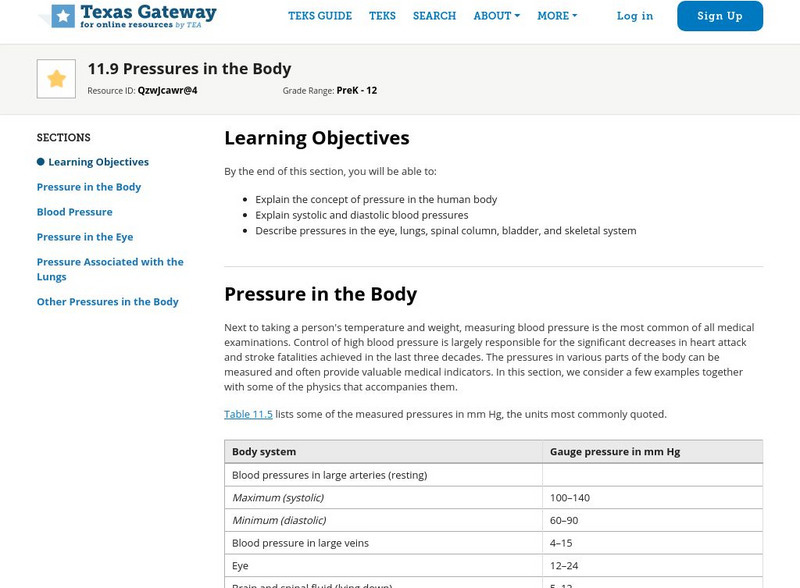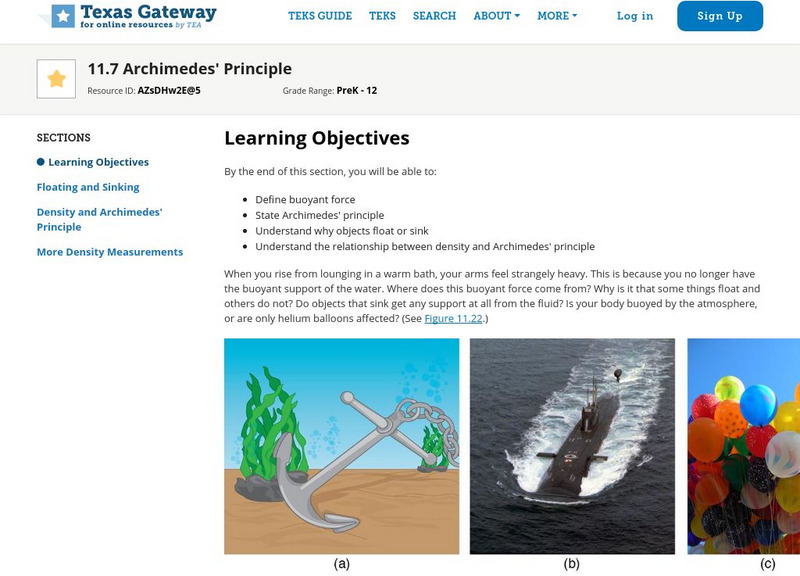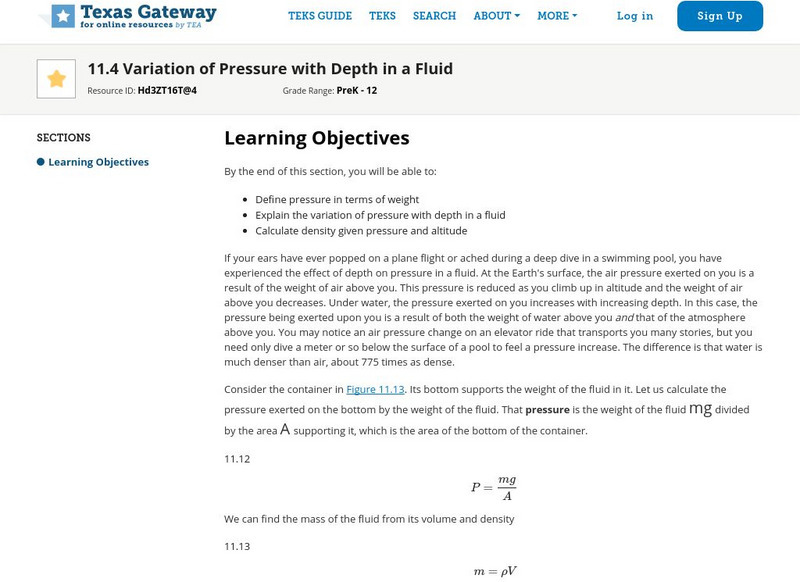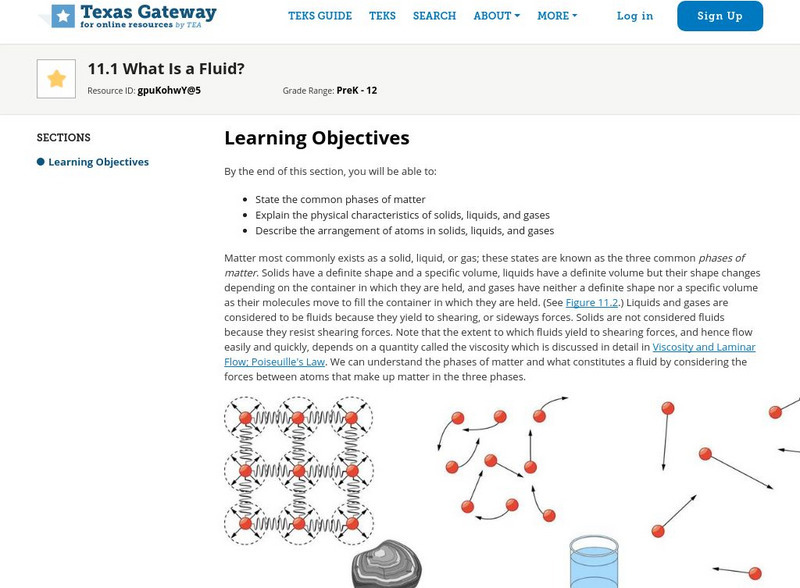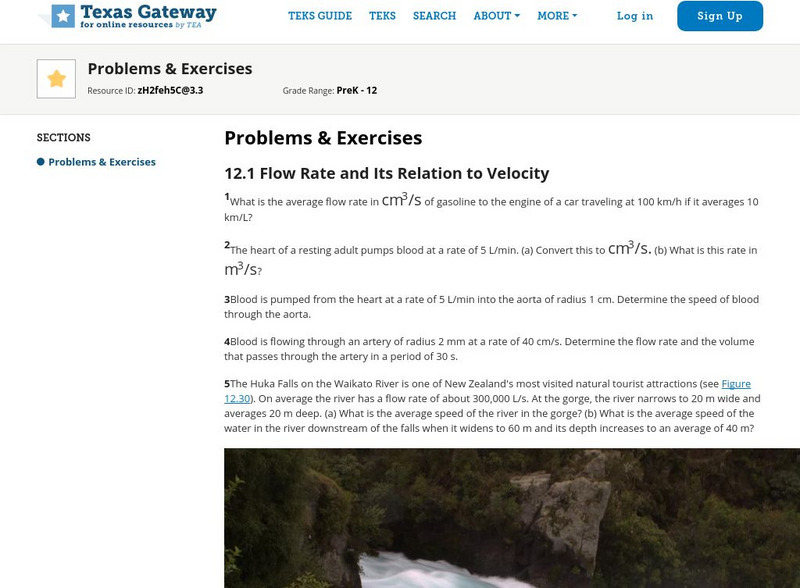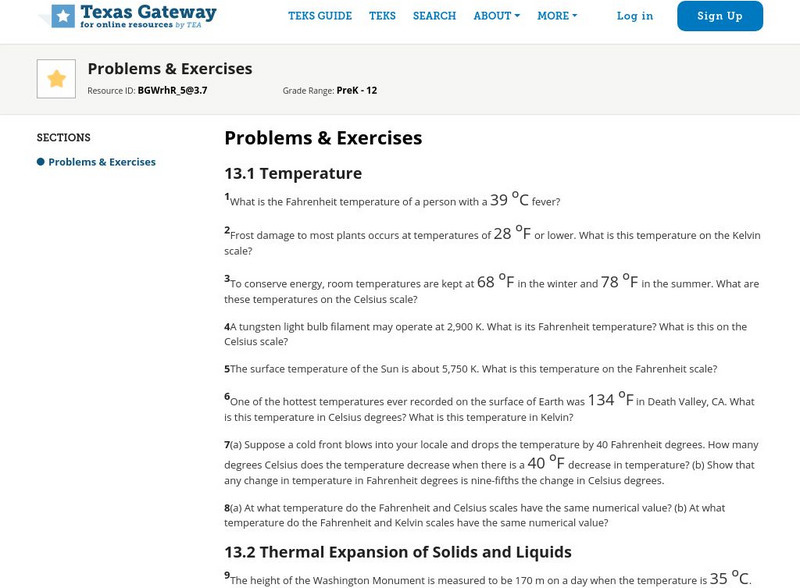Texas Education Agency
Texas Gateway: Fluid Statics: Pressures in the Body
By the end of this section, you will be able to explain the concept of pressure in the human body; explain systolic and diastolic blood pressures; and describe pressures in the eye, lungs, spinal column, bladder, and skeletal system.
Texas Education Agency
Texas Gateway: Ap Physics: Fluid Statics: Archimedes' Principle
By the end of this section, you will be able to define buoyant force, state Archimedes' principle, understand why objects float or sink, and understand the relationship between density and Archimedes' principle.
Texas Education Agency
Texas Gateway: Gauge Pressure, Absolute Pressure, and Pressure Measurement
By the end of this section, you will be able to define gauge pressure and absolute pressure and to understand the working of aneroid and open-tube barometers.
Texas Education Agency
Texas Gateway: Variation of Pressure With Depth in a Fluid
By the end of this section, you will be able to define pressure in terms of weight, explain the variation of pressure with depth in a fluid, and calculate density given pressure and altitude.
Texas Education Agency
Texas Gateway: Ap Physics: Fluid Statics: Pressure
By the end of this section, you will be able to define pressure, explain the relationship between pressure and force, and calculate force given pressure and area.
Texas Education Agency
Texas Gateway: Ap Physics: Fluid Statics: Density
By the end of this section, you will be able to define density, calculate the mass of a reservoir from its density, and compare and contrast the densities of various substances.
Texas Education Agency
Texas Gateway: Ap Physics: Fluid Statics: What Is a Fluid?
By the end of this section, you will be able to state the common phases of matter; explain the physical characteristics of solids, liquids, and gases; and describe the arrangement of atoms in solids, liquids, and gases.
Texas Education Agency
Texas Gateway: Rotational Motion and Angular Momentum: Conceptual Questions
This page provides 30 questions that cover the major concepts presented in Chapter 10: Rotational Motion and Angular Momentum from the AP Physics online text.
Texas Education Agency
Texas Gateway: Gyroscopic Effects: Vector Aspects of Angular Momentum
By the end of this section, you will be able to describe the right-hand rule to find the direction of angular velocity, momentum, and torque; explain the gyroscopic effect; and study how Earth acts like a gigantic gyroscope.
Texas Education Agency
Texas Gateway: Collisions of Extended Bodies in Two Dimensions
By the end of this section, you will be able to observe collisions of extended bodies in two dimensions and examine collisions at the point of percussion.
Texas Education Agency
Texas Gateway: Molecular Transport Phenomena: Diffusion, Osmosis, & Related Proc
By the end of this section, you will be able to define diffusion, osmosis, dialysis, and active transport and to calculate diffusion rates.
Texas Education Agency
Texas Gateway: Motion of an Object in a Viscous Fluid
By the end of this section, you will be able to calculate the Reynolds number for an object moving through a fluid, explain whether the Reynolds number indicates laminar or turbulent flow, and describe the conditions under which an...
Texas Education Agency
Texas Gateway: Heat and Heat Transfer Methods: Glossary
This is a glossary of terms and definitions used in Chapter 14: Heat and Heat Transfer Methods from the AP Physics online text.
Texas Education Agency
Texas Gateway: Temperature, Kinetic Theory, and the Gas Laws: Temperature
By the end of this section, you will be able to define temperature; convert temperatures between the Celsius, Fahrenheit, and Kelvin scales; define thermal equilibrium; and state the zeroth law of thermodynamics.
Texas Education Agency
Texas Gateway: Fluid Dynamics & Its Biological & Medical Applications: Problems
This is a list of 66 problems/exercise to solve covering the content of Chapter 12: Fluid Dynamics & Its Biological & Medical Applications from the AP Physics online Text.
Texas Education Agency
Texas Gateway: Fluid Dynamics & Its Biological & Medical Applications: Questions
This is a list of 33 questions covering the major concepts presented in Chapter 12: Fluid Dynamics & Its Biological & Medical Applications from the AP Physics online text.
Texas Education Agency
Texas Gateway: Fluid Dynamics and Its Biological & Medical Applications: Summary
This page provides a summary of the content from each section of Chapter 12: Fluid Dynamics and Its Biological & Medical Applications.
Texas Education Agency
Texas Gateway: Heat and Heat Transfer Methods: Convection
By the end of this section, you will be able to discuss the method of heat transfer by convection.
Texas Education Agency
Texas Gateway: Heat and Heat Transfer Methods: Conduction
By the end of this section, you will be able to calculate thermal conductivity, observe conduction of heat in collisions, and study thermal conductivities of common substances.
Texas Education Agency
Texas Gateway: Phase Change and Latent Heat
By the end of this section, you will be able to examine heat transfer and calculate final temperature from heat transfer.
Texas Education Agency
Texas Gateway: Temperature Change and Heat Capacity
By the end of this section, you will be able to observe heat transfer and change in temperature and mass and to calculate final temperature after heat transfer between two objects.
Texas Education Agency
Texas Gateway: Temperature, Kinetic Theory, & the Gas Laws: Problems & Exercises
This is a list of 74 problems/exercises to solve based on the content of Chapter 13:Temperature, Kinetic Theory, & the Gas Laws from the AP Physics online text.
Texas Education Agency
Texas Gateway: Temperature, Kinetic Theory, & the Gas Laws: Conceptual Questions
This page provides a list of 22 questions over the major concepts in Chapter 13: Temperature, Kinetic Theory, and the Gas Laws from the AP Physics online text.
Texas Education Agency
Texas Gateway: Temperature, Kinetic Theory, and the Gas Laws: Phase Changes
By the end of this section, you will be able to interpret a phase diagram; state Dalton's law; identify and describe the triple point of a gas from its phase diagram; and describe the state of equilibrium between a liquid and a gas, a...


